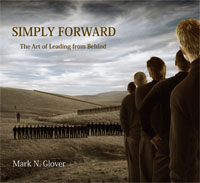 Simply Forward: The Art of Leading from Behind
Simply Forward: The Art of Leading from Behind
by Mark Glover
Introduction
The organizational structure is the foundation of a business; it dictates the entire operation from the CEO to the customer. It determines everything from the flow of communication to the execution of production. It is the base from which an organization reacts to the marketplace, meets the needs of its stakeholders, and recruits and hires employees. In addition, it is important in starting and sustaining a company’s culture and development.
The traditional organizational structure is a top-down model, and is often illustrated by a pyramid with leaders at the top. It is my assertion that this structure is poorly designed for cross-communication and interaction among employees, which stifles innovation and growth. You want your business to have as many sources of information and feedback as possible, and you want your employees to feel respected and thrive in their positions, regardless of their title.
The reason we need to change this antiquated model is because business must keep up with technology, which has changed the way we interact in the world. With the prevalence of personal computers, smart phones, and social media, organizations must be able to react to market changes as quickly as possible. A large, multi-tiered corporation cannot keep up with the pace of this environment; it has become inefficient.
Many existing companies are already experiencing problems keeping up across broad sections of the global economy. Some expend enormous resources and capital on meetings, marketing studies, and customer surveys to find out where the problem lies; they may try changing leadership, retraining employees, or redesigning compensation plans. What they do not realize is that the problem begins at the core of the enterprise.
In this book, Mark suggests a new business model, one that is more efficient and affords more opportunities for employees at every level in the organization. He calls it the Organizational Circle. Download each chapter:
Chapter 1: What Makes You the Boss? In this chapter, Mark introduces three groups in an organization, each of which has a unique and important contribution to make if given the right opportunities. He has named these three groups Drivers, Transmitters, and Navigators. The Drivers are those at the point of sale, on the assembly line, or possibly behind a broom. The Transmitters, or middle management, often serve as communicators between the Drivers and leaders, or Navigators, of a company. Navigators can include the CEO, board members, and other executive positions. Read Chapter 1.
Chapter 2: Dollars and Sense In Chapter 2, Mark describes the group of Navigators described in Chapter 1 as the executive leadership and board members of an organization elaborates on the challenges posed to this small group of individuals who is usually tasked with creating and maintaining the core business, product, or service strategy. Also in this chapter he lays out the Market to Organizational Reflective Efficiency (MORE) Window, which basically is the objective space between your organization and the market you are trying to attract. Read Chapter 2.
Chapter 3: Perfect Pearls Here you meet the Transmitters as directors, managers, or supervisors within an organization. This group of individuals is usually tasked with overseeing the everyday functions of the organization and marshalling the talents and energies of company personnel to meet company and customer needs. They are responsible for developing a winning culture, providing passionate leadership, being catalysts for change, compensating and rewarding people, and building teams. Read Chapter 3.
Chapter 4: Nine Seconds In Chapter 4, we look at the Drivers in an organization; those positions where data in your business are created, such as the point of sale or the point of service or production. These points of contact with the customer represent the “moment of truth,” or the level of success in meeting expectations. Read Chapter 4.
Chapter 5: The Man in the Blue Suit After covering leadership and establishing the three main contributors in organizations, Mark now begins discussing how modern organizations should be structured and how Navigators, Transmitters, and Drivers should coexist in practice. He introduces a circular, rather than the traditional pyramid, structure as the most efficient of shapes to keep an organization moving forward. It is at this point in the book where he describes a new model: the Organizational Circle. Read Chapter 5.
Chapter 6: Learning to Ride a Bike Chapter 6 takes a deep dive into the composition of the Organizational Circle which is designed to maximize the efficiency of communication, exposure to the marketplace, responsiveness to customer needs, application of business objectives, and execution of the business plan. The Organizational Circle will have what Mark refers to as three Bands of Influence: Strategic, Application, and Execution. Each of these bands of influence, like the individuals who govern them, is an equally important element for success. At the same time, each has a high degree of interdependence on the other. Read Chapter 6.
Chapter 7: Find a Penny In Chapter 7, you learn more about The Bands of Influence—the areas of discovery within the organization—and unlike in most traditional organizational structures individuals can circulate through each one. With such a change in structure, other areas in human resources would have to adapt to the new system. For example, I discuss recruitment and hiring, onboarding and progression, and creating windows of opportunity. Read Chapter 7.
Chapter 8 coming soon.
